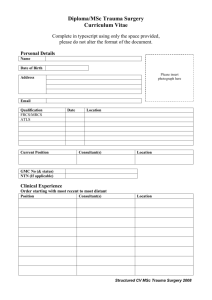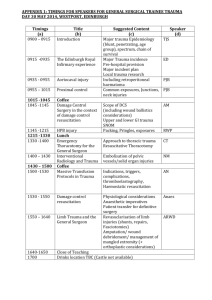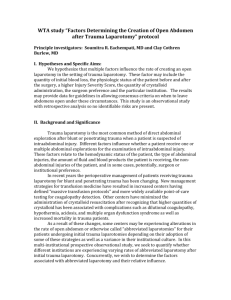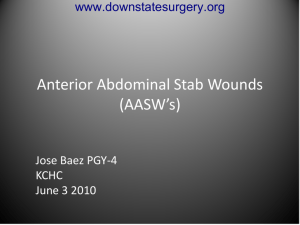Supplement 23: Trauma Damage Control Laparotomy: The “damage
advertisement
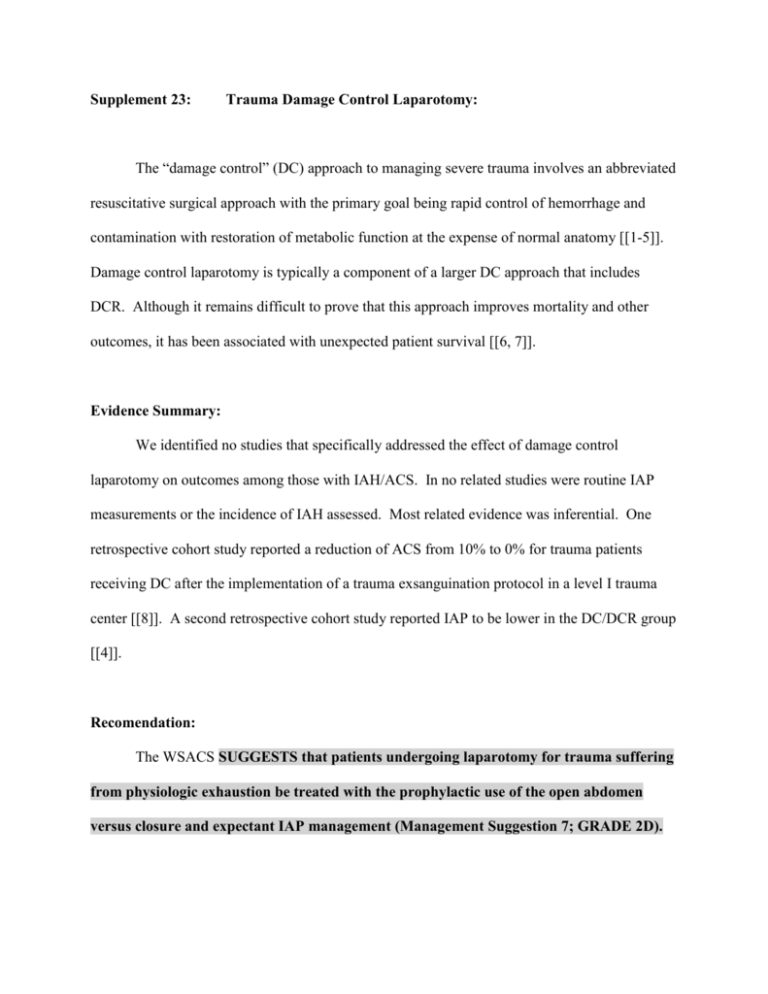
Supplement 23: Trauma Damage Control Laparotomy: The “damage control” (DC) approach to managing severe trauma involves an abbreviated resuscitative surgical approach with the primary goal being rapid control of hemorrhage and contamination with restoration of metabolic function at the expense of normal anatomy [[1-5]]. Damage control laparotomy is typically a component of a larger DC approach that includes DCR. Although it remains difficult to prove that this approach improves mortality and other outcomes, it has been associated with unexpected patient survival [[6, 7]]. Evidence Summary: We identified no studies that specifically addressed the effect of damage control laparotomy on outcomes among those with IAH/ACS. In no related studies were routine IAP measurements or the incidence of IAH assessed. Most related evidence was inferential. One retrospective cohort study reported a reduction of ACS from 10% to 0% for trauma patients receiving DC after the implementation of a trauma exsanguination protocol in a level I trauma center [[8]]. A second retrospective cohort study reported IAP to be lower in the DC/DCR group [[4]]. Recomendation: The WSACS SUGGESTS that patients undergoing laparotomy for trauma suffering from physiologic exhaustion be treated with the prophylactic use of the open abdomen versus closure and expectant IAP management (Management Suggestion 7; GRADE 2D). Rationale: DCR may reduce the need for DC laparotomy [[9]]. However, until this has been clearly established, those patients who are appropriately selected as requiring DC laparotomy are at high risk of developing post-operative ACS if the abdomen is formally closed with use of expectant IAP management. References 1. 2. 3. 4. 5. 6. 7. 8. 9. Sugrue M, D'Amours SK, Joshipura M, (2004) Damage control surgery and the abdomen. Injury 35: 642-648 Kirkpatrick AW, Ball CG, D'Amours SK, Zygun D, (2008) Acute resuscitation of the unstable adult trauma patient: Bedside diagnosis and therapy. Can J Surg 51: 57-69 Rotondo MF, Schwab CW, McGonigal MD, Phillips GR, 3rd, Fruchterman TM, Kauder DR, Latenser BA, Angood PA, (1993) 'Damage control': an approach for improved survival in exsanguinating penetrating abdominal injury. The Journal of trauma 35: 375-382; discussion 382-373 Cotton BA, Reddy N, Hatch QM, LeFebvre E, Wade CE, Kozar RA, Gill BS, Albarado R, McNutt MK, Holcomb JB, (2011) Damage control resuscitation is associated with a reduction in resuscitation volumes and improvement in survival in 390 damage control laparotomy patients. Annals of surgery 254: 598-605 Cirocchi R, Abraha I, Montedori A, Farinella E, Bonacini I, Tagliabue L, Sciannameo F, (2010) Damage control surgery for abdominal trauma. Cochrane database of systematic reviews: CD007438 Johnson JW, Gracias VH, Schwab CW, Reilly PM, Kauder DR, Shapiro MB, Dabrowski P, Rotondo MF, (2001) Evolution in damage control for exsanguinating penetrating abdominal injury. J Trauma 51: 261-271 Finlay IG, Edwards TJ, Lambert AW, (2004) Damage control laparotomy. The British journal of surgery 91: 83-85 Cotton BA, Au BK, Nunez TC, Gunter OL, Robertson AM, Young PP, (2009) Predefined massive transfusion protocols are associated with a reduction in organ failure and postinjury complications. J Trauma 66: 41-48; discussion 48-49 Schreiber MA, (2012) The beginning of the end for damage control surgery. The British journal of surgery 99 Suppl 1: 10-11



